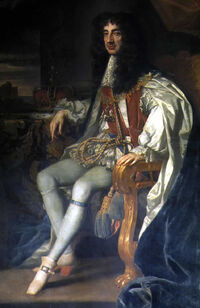
Charles II of England
The Rye House Plot of 1683 was a plan to assassinate King Charles II of England and his brother (and heir to the throne) James, Duke of York. Historians vary their assessment of the degree to which details of the conspiricy were finalized.
The Trouble Begins[]
After the Restoration of the monarchy under Charles in 1660 there was concern among some members of parliament, former republicans and the general Protestant population of England that the King's relationship with France under Louis XIV and the other Catholic rulers of Europe was too close. Anti-Catholic sentiment, which associated Catholicism with absolutism, was widespread, and focused particular attention on the succession to the throne. Whiles Charles was publicly Anglican, he and his brother were known to have Catholic sympathies. These Suspicions were confirmed in 1673 when James was discovered to have converted to Catholicism.
The Plot[]
In 1681, triggered by the opposition-invented Popish Plot, which claimed the lives of many people including William Howard, 1st Viscount Stafford, the Exclusion Bill was introduced to the House of Commons, which would have excluded James from the succession. Charles outmanoeuverd his opponents and dissolved Parliament. This left his opponents with no legal method of preventing James's succession, and rumours of plots and conspiracies abounded. With the "County Party" or later The Whigs as they were known were in disarray, The Earl of Melville, The Earl of Leven and even The Earl of Shaftesbury, leader of the opposition to Charles's rule, fled to Holland where Shaftesbury soon died.
Rye House, was a manor house in Hoddesdon in Hertfordshire, was owned by well-known Republican Richard Rumbold. The Plan was to conceal a force of 100 men in the grounds of the house and ambush the King and Duke ont heir way back to London fro the horse races at Newmarket.
They were expected to make the journey on 1 April 1683, but there was a great fire in Newmarket on 22 March, which detroyed half the town. The races were cancelled, and the King and Duke returned to London early. As a result, the planned attack never took place.
Aftermath after the plot becomes known[]
News of the plot leaked and the it was publicly discovered on 12 June 1683; Charles and his supporters were quick to act:a Royal Declaration of henious nature of the plot was 27 July. Many members of Parliament and noblemen of the "Country Party", which opposed the "Court Party" later to become The Tories, were arrested, stood trial and found guilty:
- Whig MP for Tavistock - William Russell, Lord Russell - Executed by beheading
- Whig MP for Stafford - Sir Thomas Armstrong - Executed by beheading
- The Hon. Algernon Sidney - Executed by beheading
- The Earl of Essex - Commited suicide in the Tower of London
- The Lord Grey of Werke - Escaped from the Tower
- Whig MP for Wendovers - John Hampden - Imprisoned after being unable to pay the £40,000 fine
- The Lord Howard of Escrick - Arrested but turned informer and gave accounts on the secret meetings, which helped to convict and execute Russell and Sidney
- Richard Rumbold - Executed by hanging
- James Scott, 1st Duke of Monmouth, Charles' illegitimate son, was also implicated and obliged to retire to the United Provinces. He was later executed by beheading for leading another rebellion which also saw Archibald Campbell, Earl of Argyll beheaded for being a part of the revolt.










